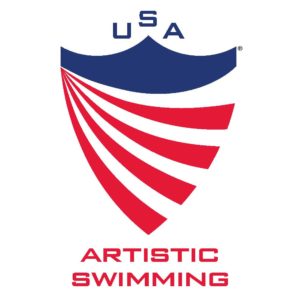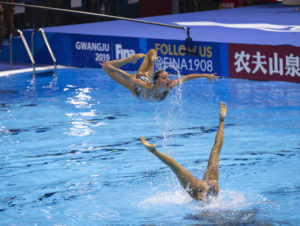USA Synchro Rebrands to USA Artistic Swimming
The NGB is taking on the name that the sport has adopted at the international level
Posted On: March 2, 2020 By :The sport of synchronized swimming has always been about alignment. The precision moves of the athletes to music form the basis of the sport’s scoring as well as the appeal for fans, who appreciate the athleticism and artistry involved in the choreography.
But at the international level, the alignment over what the sport should be called has caused some soul-searching in recent years. In 2017, the sport’s international federation, FINA, approved a name change to “artistic swimming,” a term the federation felt better reflected the sport’s essence. As a result, the sport’s national governing bodies were faced with a choice of their own—namely whether to include the new name in their organizational titles. Over the past two years, many gradually chose to make the switch.
Now this sweeping change has reached the United States. After a recent board vote that takes public effect March 2, the NGB previously known as USA Synchro is changing its name and its brand to USA Artistic Swimming.
“Slowly but surely, we’ve seen more and more countries adopt it,” said CEO Adam Andrasko. “Canada was one of the first to do it two years ago. There are 19 of the top 25 countries in the world that are either partially or fully using the name artistic swimming.”
Synchronizing the Name With the Sport
The rebrand globally and now in the United States is rooted in a long-held misunderstanding of the sport. The term “synchronized swimming” has always had a disconnect with casual fans in that “synchronized” as used here refers to the swimmers’ ability to time their moves to the music, not to each other. Without that understanding, “synchronized” also causes confusion for those watching solo competitors, which is a discipline at the world championship level.
 The rebrand is significant for USA Artistic Swimming as the sport has its origins in the United States. But what began as water ballet has emerged in modern times as a sport requiring athletes to have more power than finesse, not unlike the shift that has occurred in figure skating in recent years.
The rebrand is significant for USA Artistic Swimming as the sport has its origins in the United States. But what began as water ballet has emerged in modern times as a sport requiring athletes to have more power than finesse, not unlike the shift that has occurred in figure skating in recent years.
“When you throw an individual athlete out of the water to execute a double backflip or a 720—a high-level, high-height move—that’s an individual athlete flying through the air,” Andrasko noted. “We have to tell a better story of how athletic these athletes are and how powerful they are. Too many people still associate us with water ballet, and that brings in a misrepresentation of the sport in the standard sports fan’s mind.”
The timing of the rebrand is deliberate as Team USA, which has not qualified its full squad for the Olympic Games since 2008, is in the mix to qualify for the 2020 Games, where the sport will be referred to as artistic swimming for the first time. During the week of March 2, FINA hosts a competition in France that will be the first of several significant events leading up to the Games in Tokyo. While five qualifying spots remain open for the Olympics, four teams are realistically vying for one of those remaining positions: the U.S., Greece, France and Mexico. “If this is March Madness, we are the bubble team,” Andrasko said. The U.S. is in strong position to send a duet team to Tokyo based on international rankings, but it is seeking to send its full team as well.
With the final round of qualifying commencing, Andrasko and the leaders of USA Artistic Swimming are hoping that the rebrand will be top of mind at the event in France and future competitions in a sport that is judged and where perceptions are crucial. “We want to build a bunch of buzz at the French Open that hopefully turns all the attention to us,” Andrasko said.
Powering Through to Greater Growth
While its name is changing, the organization’s shield logo will remain. Some continuity may be beneficial, especially as Andrasko noted there are few examples of a national governing body switching to an entirely new name.
USAAS (as its acronym will be known) has 7,000 members. Appealing to those members and trying to attract new ones are part of the rebrand’s goal as well.

“Number one, it’s a brand change and an organizational name change,” Andrasko said. “Number two, it’s a membership campaign. And No. 3, it’s an announcement that our national team is back and prepared to return to the Olympic Games. But membership will lead to the longest growth and opportunity in our organization.”
The shift comes as the governing body, based in Colorado Springs, Colorado, seeks to become more professional. This year, for the first time in 12 years, national team members will be paid, a significant development in itself for an NGB with a budget of $1.8 million, only $91,000 of which comes from the U.S. Olympic and Paralympic Committee. The USOPC does provide grants to help support the business and finance side of the organization’s operation, which has eight full-time positions. Additional revenue comes from membership fees, events, sponsorship and philanthropy.
A commitment to travel is a component as well. USAAS will see its team travel to international competitions at a greater rate in 2020 than any other year in its history, to provide the team with more exposure and experience on the world stage.
“We’re moving in a direction that is more professionalized as an organization,” Andrasko said. “And this name change is a part of that.”
Posted in: Artistic Swimming, Main Feature, National Governing Body